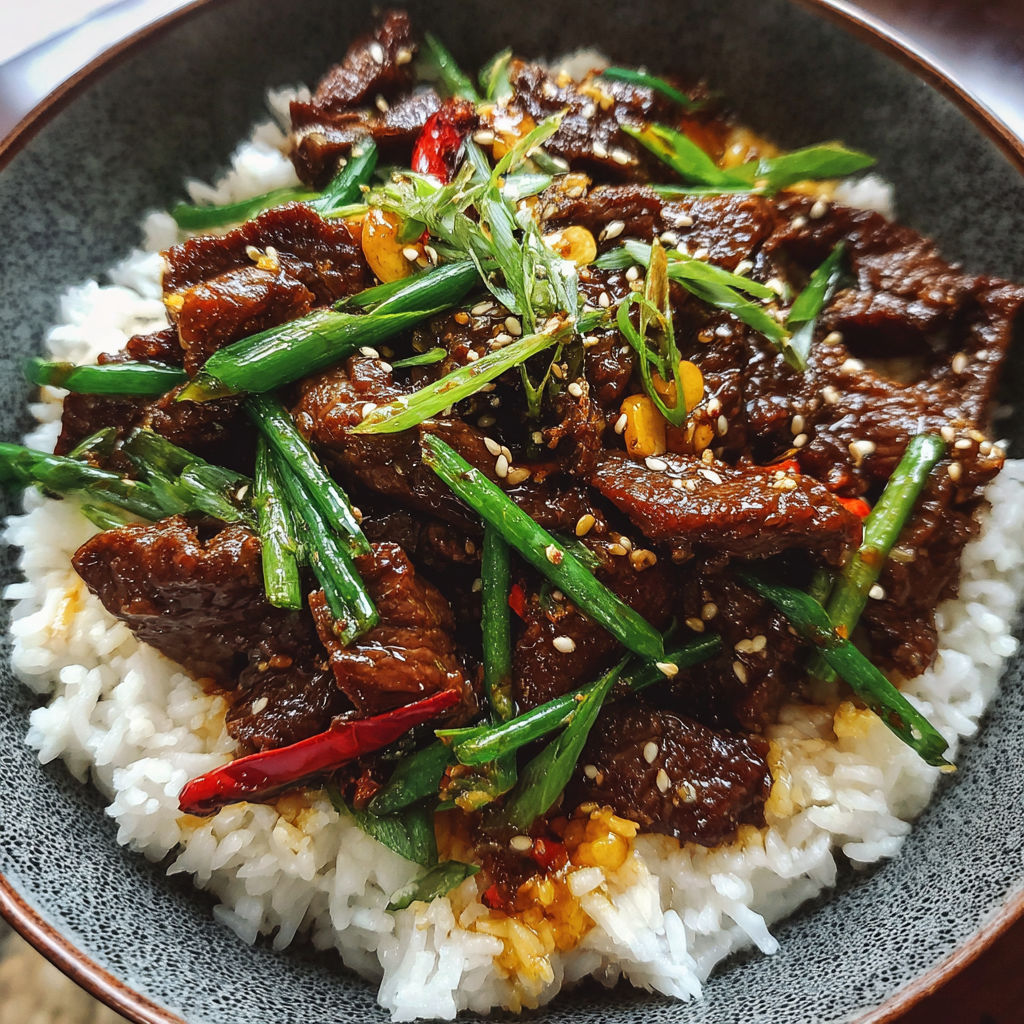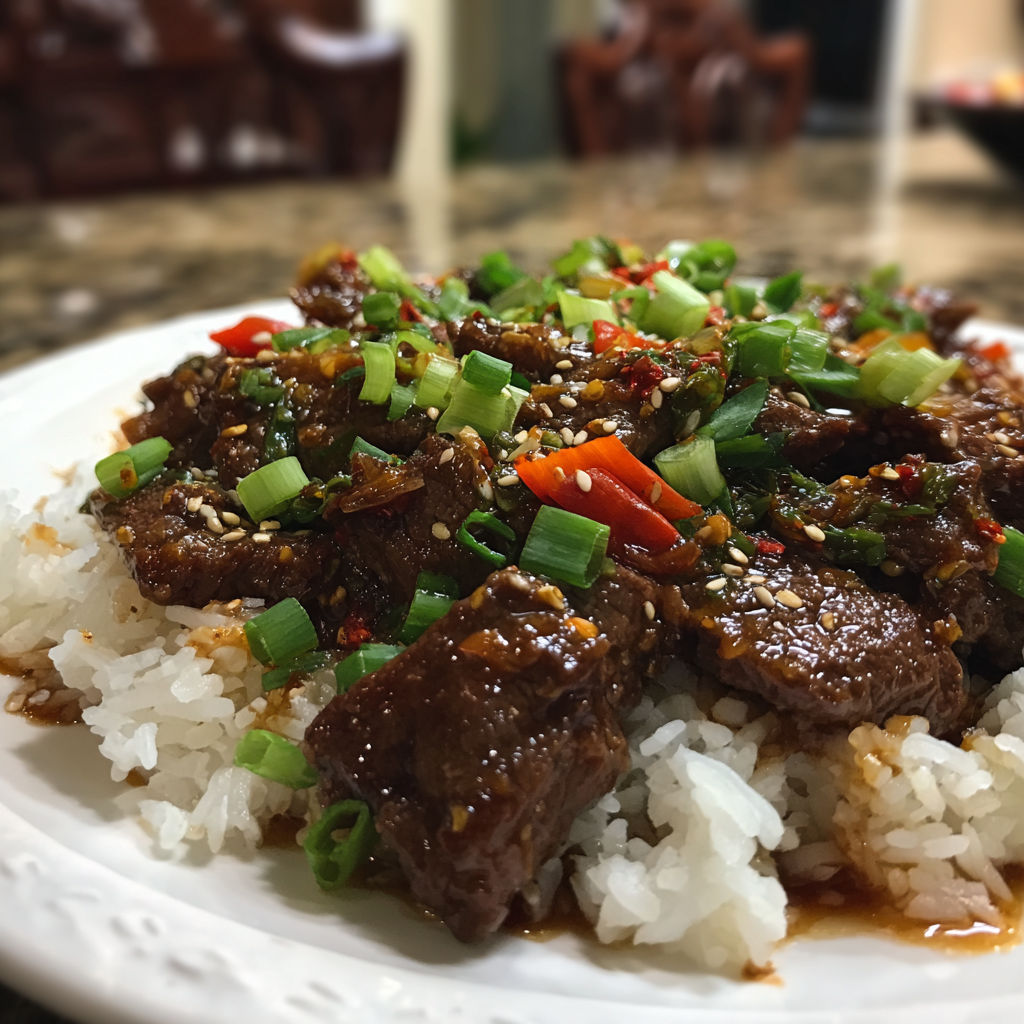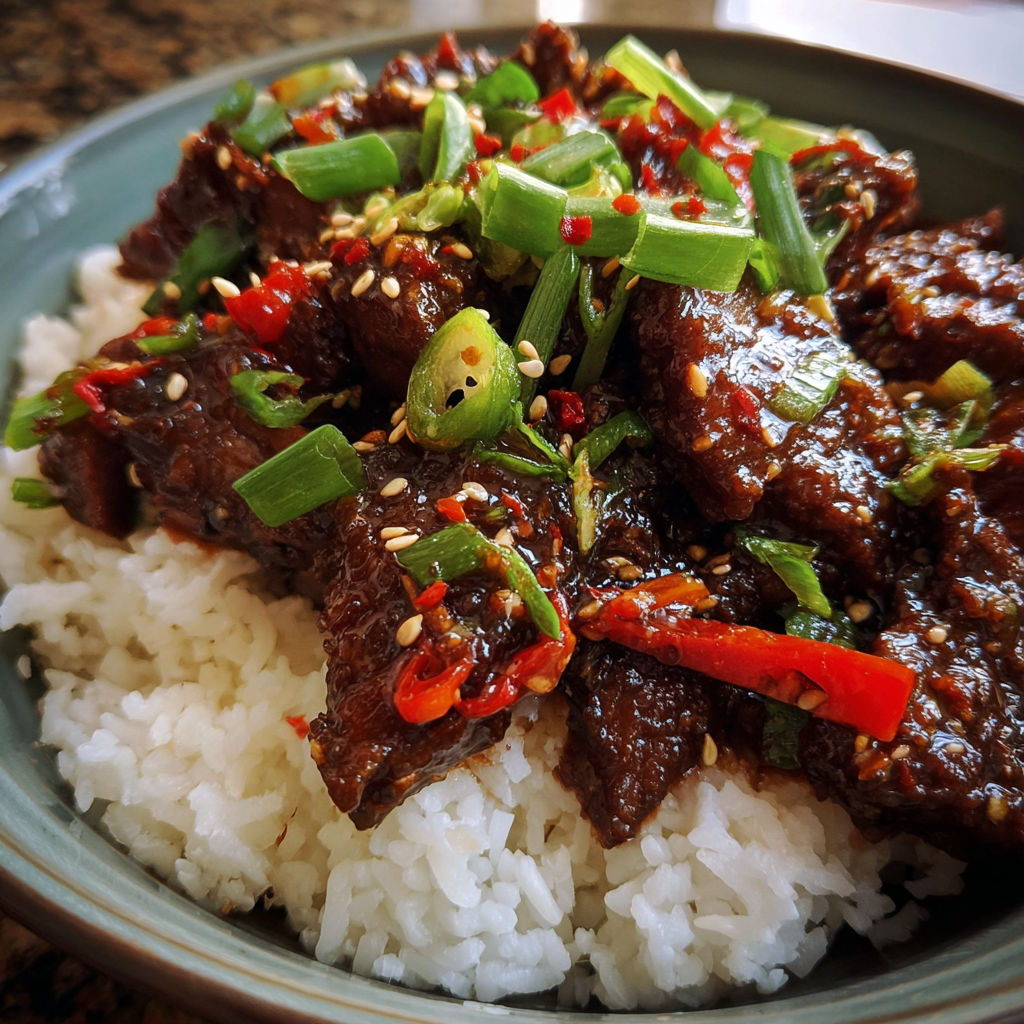 Markieren
Markieren
Mongolian Beef is every bit as savory and mouthwatering as takeout and comes together in less time than delivery. I grew up making this dish for family birthday dinners and have perfected a sauce that clings to each tender piece of steak just right.
I remember making this for a last-minute dinner guest and seeing everyone go for seconds—the sweet-savory sauce always wins new fans at my table.
Ingredients
- Flank steak: Choose the freshest you can find with good marbling for tenderness. Thin slices are key.
- Cornstarch: Helps create a crisp crust on each slice and thickens the sauce. Make sure it looks powdery and isn’t clumped.
- Vegetable oil: High smoke point for quick frying. Select a neutral flavor.
- Garlic: Fresh cloves add sharp depth. Look for firm unblemished bulbs.
- Fresh ginger: Brightens the sauce and adds zing. Knobby roots with smooth skin are best.
- Soy sauce: Salty base and umami. Choose a quality regular soy sauce for depth.
- Water: Adjusts the sauce consistency. Use clean filtered water if possible.
- Brown sugar: Gives a subtle sweetness and glossy finish. Dark brown sugar adds more richness.
- Red pepper flakes: Optional for heat but adds warm undertones. Check for a vibrant red color.
- Green onions: Tie everything together with a fresh crunch. Pick ones with firm stalks and vivid green tops.
- Sesame oil: Adds toasty fragrance and complexity. Go for pure toasted sesame oil for bold flavor.
Instructions
- Slice and Prep the Steak:
- Start by cutting the flank steak into very thin slices across the grain. Each piece should be about an eighth of an inch thick. This ensures every bite is tender and easy to eat. Toss the slices thoroughly in cornstarch until each piece is evenly coated and let them rest for at least ten minutes. This step helps the beef develop a delicate crust during cooking.
- Cook the Beef:
- Heat a wide skillet or wok on medium high and pour in the vegetable oil. When the oil just begins to shimmer, add a layer of steak pieces making sure not to overcrowd. Fry two or three minutes on each side until a golden crisp forms on the outside. Transfer to a plate and repeat with the rest of the steak.
- Build the Base:
- Reduce the heat to medium and in the same skillet add freshly minced garlic and grated ginger. Stir for half a minute until their aroma fills the kitchen. This releases the flavors into the oil and gives the sauce its robust profile.
- Make the Sauce:
- Pour in the soy sauce and water ensuring you stir up any browned bits from the bottom of the pan. Add brown sugar and let everything combine. As the mixture comes to a gentle simmer, keep stirring for three to four minutes until the sauce thickens and turns glossy. Sprinkle in red pepper flakes now if you want a touch of heat.
- Finish the Dish:
- Return the cooked beef to the skillet. Stir it into the sauce so each slice gets evenly coated. Simmer for one or two minutes to help the flavors meld.
- Add Greens and Oil:
- Scatter the sliced green onions over the beef and then drizzle in the sesame oil. Stir a final time and once everything is glistening and fragrant remove from the heat.
- Plate and Serve:
- Spoon the beef over a big bowl of freshly steamed rice or your favorite noodles. Serve right away while hot and tender.

The sesame oil is my secret weapon—the aroma instantly brings me back to the first time I cooked this on a small electric stove in my first apartment. I was so proud to make something that tasted better than takeout for my dad.
Storage Tips
Let leftovers cool completely before storing. Seal in an airtight container and refrigerate for up to three days. Reheat gently in a skillet with a splash of water to refresh the sauce.
Ingredient Substitutions
You can swap flank steak with sirloin or even chicken thighs if preferred. Tamari stands in for soy sauce in gluten free versions. Honey or coconut sugar works for the brown sugar in a pinch.
Serving Suggestions
Pile the beef over fluffy jasmine or basmati rice. If you are craving vegetables, add a side of steamed broccoli or bok choy. For gatherings, serve Mongolian Beef family style for everyone to dig into together.
Cultural Notes
Mongolian Beef as we know it is a Chinese American creation rather than a dish from Mongolia. The sweet soy sauce based gravy and quick searing remind me of the vibrant flavors of modern Chinese restaurant classics.
Seasonal Adaptations
Stir in snap peas or baby bok choy in spring. Add red bell pepper strips or zucchini in summer. Toss with roasted sweet potatoes or squash in fall.
Success Stories
A friend once doubled the recipe for a potluck and it was the only dish gone before dessert. My family always asks for extra green onions because the fresh bite is unforgettable.
Freezer Meal Conversion
Freeze cooked beef and sauce together in a zipper bag. Squeeze out air and lay flat. Label with date and freeze up to two months. Thaw overnight in the fridge before reheating.

Once you’ve learned the technique, Mongolian Beef is quick enough for a weeknight but special enough for company. The caramelized sauce and fresh onions always bring rave reviews.
Fragen & Antworten zu Rezepten
- → What cut of beef works best for Mongolian beef?
Flank steak is ideal due to its tenderness when sliced thinly against the grain, absorbing flavors well.
- → How do I make the beef extra tender?
Slicing flank steak thinly against the grain and coating with cornstarch helps ensure juicy, tender bites.
- → Can I adjust the sweetness of the sauce?
Yes, modify the amount of brown sugar to taste for a less or more sweet profile.
- → What are good sides for Mongolian beef?
Steamed white rice or noodles work perfectly to soak up the delicious sauce.
- → Is Mongolian beef spicy?
The dish has mild heat from red pepper flakes, but you can reduce or omit them for a milder flavor.
- → How long does it take to cook?
Cooking and preparation can be completed in about 40 minutes for a quick meal.
